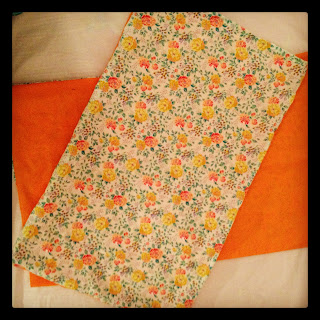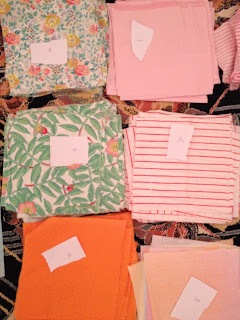 |
| Finished patchwork quilt/duvet topper |
Dear Readers,
You may have read about my first ever DIY which was bright 'Sunshine' patchwork duvet cover tutorial.
After I finished that project, would you believe I still had assorted pieces of fabric leftover from my mum's various projects, so I decided on doing another patchwork duvet/quilt topper.
This one has a more spring/'summer bloom' theme to it.
I think it looks better in real life than the finished pics becasue of how some of the prints reflect light.
Things you will need:
6 types of fabric, ideally 3 plain and 3 printed, ideally to alternate. You can use whatever you have whatever works for you.
The amount you need for each fabric depends on what size quilt topper/ duvet cover you would like to make.
I was making one for a king size duvet cover which is 220cm by 225cm.
The pattern requires us to make a square quilt made up of 13 squares.
So each square will be Size of quilt +1cm/13 in my case 220+1/13 =17cm
17cm should be the finished size of each square. that means leaving a half cm allowance for stitching on each side, you should cut out 18cm squares.
The pattern requires 27 squares of each fabric, thats approximately 100cm *127cm for
Fabric number 6 requires 28 squares, so you'll need a bit more fabric.
You may require extra fabric to make sure the finished quilt covers the bed/duvet, as the square topper is only going to be 221 cm I will add a 5 cm strip to one end, you could add two 2.5 cm to both ends.
Remember that fabric number 6 will be the most prominent one, according to the pattern, so choose carefully. In my pattern no. 6 is large green leaves with orange flowers print (middle left ), 5 the orange fabric, 4 the smalle green leaves and yellow and organge flowers(top left) 3 the light shaded fabric(bottom right) 2 red and white horizontal stripes, 1-pink background with fine white lines printed it on it.
Other things you will need:
Scissors/ Rotary blade and Cutting board
Ruler/Quilters Square
Chalk
Matching thread. Sewing maching
Iron
Pattern:
| 6 | 1 | 2 | 3 | 4 | 5 | 6 | 5 | 4 | 3 | 2 | 1 | 6 |
| 1 | 2 | 3 | 4 | 5 | 6 | 1 | 6 | 5 | 4 | 3 | 2 | 1 |
| 2 | 3 | 4 | 5 | 6 | 1 | 2 | 1 | 6 | 5 | 4 | 3 | 2 |
| 3 | 4 | 5 | 6 | 1 | 2 | 3 | 2 | 1 | 6 | 5 | 4 | 3 |
| 4 | 5 | 6 | 1 | 2 | 3 | 4 | 3 | 2 | 1 | 6 | 5 | 4 |
| 5 | 6 | 1 | 2 | 3 | 4 | 5 | 4 | 3 | 2 | 1 | 6 | 5 |
| 6 | 1 | 2 | 3 | 4 | 5 | 6 | 5 | 4 | 3 | 2 | 1 | 6 |
| 5 | 6 | 1 | 2 | 3 | 4 | 5 | 4 | 3 | 2 | 1 | 6 | 5 |
| 4 | 5 | 6 | 1 | 2 | 3 | 4 | 3 | 2 | 1 | 6 | 5 | 4 |
| 3 | 4 | 5 | 6 | 1 | 2 | 3 | 2 | 1 | 6 | 5 | 4 | 3 |
| 2 | 3 | 4 | 5 | 6 | 1 | 2 | 1 | 6 | 5 | 4 | 3 | 2 |
| 1 | 2 | 3 | 4 | 5 | 6 | 1 | 6 | 5 | 4 | 3 | 2 | 1 |
| 6 | 1 | 2 | 3 | 4 | 5 | 6 | 5 | 4 | 3 | 2 | 1 | 6 |
Method:
1. Cut out squares of each fabric, make sure you measure properly, otherwise you will be sorry at some point, and then unless you have tonnes of fabric it will be too late to do anything about it.
2. Play around with the fabric, until you can decide which fabric is going to be 1,2,3 and so on.
I would make the darkest/brightest 6, and the lightest 1,and the rest according to how they would look next to each other.
3. Once you have decided which number to assign each fabric, place a sticky note or piece of paper atop each pile so you don't get mixed up.
4. For the first row collect all the squares in the correct order.
Placing the first two squares right sides facing each other stitch together 0.5cm from the edge. Flatten the seam open with your nail. Next open up the two squares, sew on the next square in the same way until all squares in the first row or sewn together. Cut away any lose thread, fold and set aside.
Be accurate in your 0.5cm seams as it will matter later on.
Repeat for all rows.
5. Once you are finished with rows iron the rows and press seams open.
6. Next carefully pin the first and second row together, making sure the intersections/seams of the squares match up. If they don't match you could to open it up and try and tidy up the squares.If it is still don't panic! Don't give up- take a break. At the end of the day, the pattern will be seen from afar, and the mistake won't be that noticable-hopefully. :-)
Stitch together the first two rows, roll up the finished squares of fabric as you go along to prevent it from tugging and pulling what you are currently stitiching.
7. Repeat until you reach the 7th row.
Then start the same procedure from the 8th row till the bottom. This is to reduce the bulk you have handle, and so that you only have to deal with the full bulk of the fabric once.
Stitch the two halves together.
In my case, I needed to attach, a strip of fabric to the edge to make up the extra 5 cm of width.
If you are making a duvet cover like myself, you can simply sew a flat sheet cut to size, to get the back of the quilt.
If you have leftover fabric, you can make pillows, be as creative or as simple as you want.
Enjoy!
Tip: Once you have laundered it, and if you are not going to use it immediately, you could fold the cover, and store it in a pillow case,and any matching bedsheet, and additonal pillow cases, neat and organised storage.
 |
| Finished patchwork quilt/duvet topper |
 |
| Monogrammed with a S |
 |
| Pillowcase front and back |



Good morning how are you?
ReplyDeleteMy name is Emilio, I am a Spanish boy and I live in a town near to Madrid. I am a very interested person in knowing things so different as the culture, the way of life of the inhabitants of our planet, the fauna, the flora, and the landscapes of all the countries of the world etc. in summary, I am a person that enjoys traveling, learning and respecting people's diversity from all over the world.
I would love to travel and meet in person all the aspects above mentioned, but unfortunately as this is very expensive and my purchasing power is quite small, so I devised a way to travel with the imagination in every corner of our planet. A few years ago I started a collection of used stamps because trough them, you can see pictures about fauna, flora, monuments, landscapes etc. from all the countries. As every day is more and more difficult to get stamps, some years ago I started a new collection in order to get traditional letters addressed to me in which my goal was to get at least 1 letter from each country in the world. This modest goal is feasible to reach in the most part of countries, but unfortunately it’s impossible to achieve in other various territories for several reasons, either because they are countries at war, either because they are countries with extreme poverty or because for whatever reason the postal system is not functioning properly.
For all this I would ask you one small favor:
Would you be so kind as to send me a letter by traditional mail from Saudi Arabia? I understand perfectly that you think that your blog is not the appropriate place to ask this, and even, is very probably that you ignore my letter, but I would call your attention to the difficulty involved in getting a letter from that country, and also I don’t know anyone neither where to write in Saudi Arabia in order to increase my collection. a letter for me is like a little souvenir, like if I have had visited that territory with my imagination and at same time, the arrival of the letters from a country is a sign of peace and normality and an original way to promote a country in the world. My postal address is the following one:
Emilio Fernandez Esteban
Avenida Juan de la Cierva, 44
28902 Getafe (Madrid)
Spain
If you wish, you can visit my blog www.cartasenmibuzon.blogspot.com where you can see the pictures of all the letters that I have received from whole World.
Finally I would like to thank the attention given to this letter, and whether you can help me or not, I send my best wishes for peace, health and happiness for you, your family and all your dear beings.
Yours Sincerely
Emilio Fernandez
This thing used to be very famous but I don't think people are making it more.
ReplyDelete